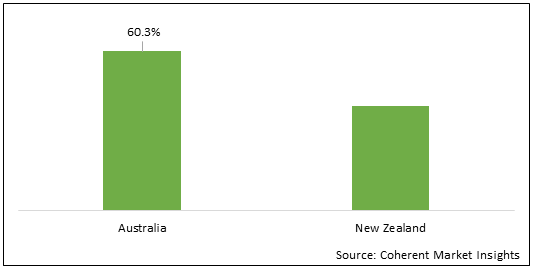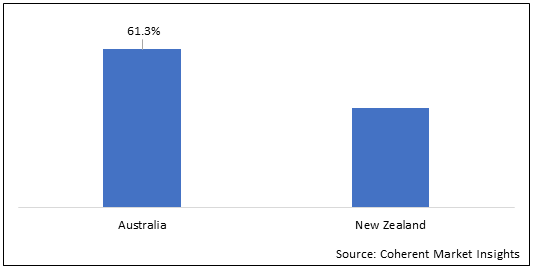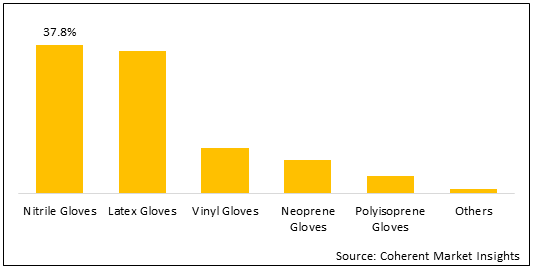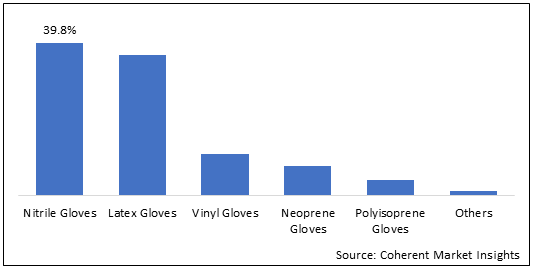Cleanroom gloves are designed to protect either products from contamination or the wearer from exposure to chemicals. Gloves such as cleanroom gloves, sterile gloves, and cleanroom hand protection products are used for protection of hands as well as while working in controlled environment. One cannot use boxed gloves while working in cleanroom, specifically the one which are labelled with any name or logo. Longer length cleanroom gloves gives popularity of increased awareness and need for extra personal or product protection.
Glove of traditional length utilized in cleanroom is 300mm/12 inches. The wearer should have the increased protection while handling hazardous chemicals (chemotherapy drugs) from a glove that is 400mm/16” in length, till the forearm is covered and protected from exposure to harmful chemicals.
Australia and New Zealand cleanroom gloves market is estimated to be valued at US$ 59.64 Mn in 2021 and is expected to reach US$ 87.20 Mn by 2028, exhibiting a CAGR of 5.6% during the forecast period (2021-2028)
Figure 1. Australia and New Zealand Cleanroom Gloves Market (%), By Country, 2021

To learn more about this report, Request sample copy
Figure 1.2. Australia and New Zealand Cleanroom Gloves Market (%), By Country, 2028

To learn more about this report, Request sample copy
Market players are engaged in inorganic activities such as acquisitions, partnerships, and others, in order to expand their product portfolio. This is expected to drive growth of the Australia and New Zealand cleanroom gloves market over the forecast period. For instance, in July 2021, Honeywell and Premier Inc., a leading technology-driven healthcare improvement company, announced a new commercial partnership aimed at increasing domestic production of nitrile exam gloves.
Australia and New Zealand Cleanroom Gloves Market Report Coverage
| Report Coverage | Details | ||
|---|---|---|---|
| Base Year: | 2020 | Market Size in 2021: | US$ 59.64 Mn |
| Historical Data for: | 2017 to 2020 | Forecast Period: | 2021 to 2028 |
| Forecast Period 2021 to 2028 CAGR: | 5.6% | 2028 Value Projection: | US$ 87.20 Mn |
| Geographies covered: |
|
||
| Segments covered: |
|
||
| Companies covered: |
Ansell Ltd., Kimberly-Clark Worldwide, Inc., Valutek Inc., Cardinal Health, Honeywell International Inc., Sabre Medical Pty Ltd., The Glove Company, and RS Components Pty Ltd. |
||
| Growth Drivers: |
|
||
| Restraints & Challenges: |
|
||
| Opportunities: |
|
||
Uncover macros and micros vetted on 75+ parameters: Get instant access to report
Figure 2. Australia and New Zealand Cleanroom Gloves Market Value (US$ Mn), By Product Type, 2021

To learn more about this report, Request sample copy
Figure 2.1. Australia and New Zealand Cleanroom Gloves Market Value (US$ Mn), By Product Type, 2028

To learn more about this report, Request sample copy
The increasing investments in healthcare industry is expected to augment research and development activities, which in turn is expected to increase usage of cleanroom gloves.
The increasing product launches and approvals are expected to drive the market growth over the forecast period.
For instance, in September 2017, Ansell Ltd. introduced Microflex 93-850, a tough, disposable nitrile glove that provides a higher level of protection for workers in hazardous environments. This innovative new hand protection solution significantly reduces the risk of chemical waste, and other hazardous materials exposure. It offers chemical splash protection similar to nitrile gloves, along with the large barrier quality and stability as the first glove to accomplish a low AQL of 0.40
Australia and New Zealand Cleanroom Gloves Market – Impact of Coronavirus (COVID-19) Pandemic
The coronavirus (COVID-19) pandemic is the most recent outbreak, which was first reported on December 31, 2019, in Wuhan, China. In Australia, the first COVID-19 case was confirmed in late January 2020, while in New Zealand, the first case was confirmed in late February 2020.
Lockdown was imposed in several countries globally, including Australia (March 13, 2020) and New Zealand (March 25, 2020), which had a negative impact on the economy of the private healthcare sector. The shutdown disrupted the supply, distribution, and manufacturing of medical supplies globally. Moreover, due to social distancing, the footfall in clinics and health institutions has fallen by more than 70% during this pandemic, which has led to decrease in the number of surgical procedures, clinical trials, research and development activities and others, which has negatively impacted the market growth.
However, the COVID-19 pandemic has increased the demand for PPE kits and gloves, which has led to increase in production of PPE kits, thereby, assisting the market growth.
Moreover, on March 03, 2020, the World Health Organization (WHO) estimated that approximately 76 million gloves, 1.6 million goggles, and 89 million masks were required globally for tackling COVID-19 pandemic. Furthermore, healthcare providers were facing challenges in terms of additional manpower, equipment, consumables, and other resources which are required to ensure safety in hospitals and provide treatment to patients with other diseases, which has also impacted the market negatively. The COVID-19 pandemic has led to the rise in the price of personal protective equipment (PPE) by 100-200%, especially for the frontline health workers.
Australia and New Zealand Cleanroom Gloves Market Restraint
Gloves act as a barrier to avoid the transmission of microbial infection from healthcare professionals to patients during surgical procedures and vice versa. However, to act as a barrier, the efficiency of the cleanroom gloves should remain intact while performing research and development activities and others.
Risk of perforations in cleanroom gloves and duration of wearing of gloves specifically during various activities such as handling harmful chemicals and others can reduce its safety and effect in preventing the harmful effects of the chemical on the skin.
For instance, according to the article published in National Center for Biotechnology Information (NCBI) in March 2016, the perforation rate in the single gloves is 15.2%, in double gloves is 14.4%, in emergency operations is 15.5%, and in elective surgery is 14.3%.
Key Players
Share
Share
Missing comfort of reading report in your local language? Find your preferred language :
Transform your Strategy with Exclusive Trending Reports :
Frequently Asked Questions
Select a License Type
Credibility and Certifications

860519526

9001:2015
27001:2022


Joining thousands of companies around the world committed to making the Excellent Business Solutions.
View All Our Clients
US Reciprocal Tax Impact Analysis On Australia And New Zealand Cleanroom Gloves Market
Stay updated on tariff changes with expert insights and timely information